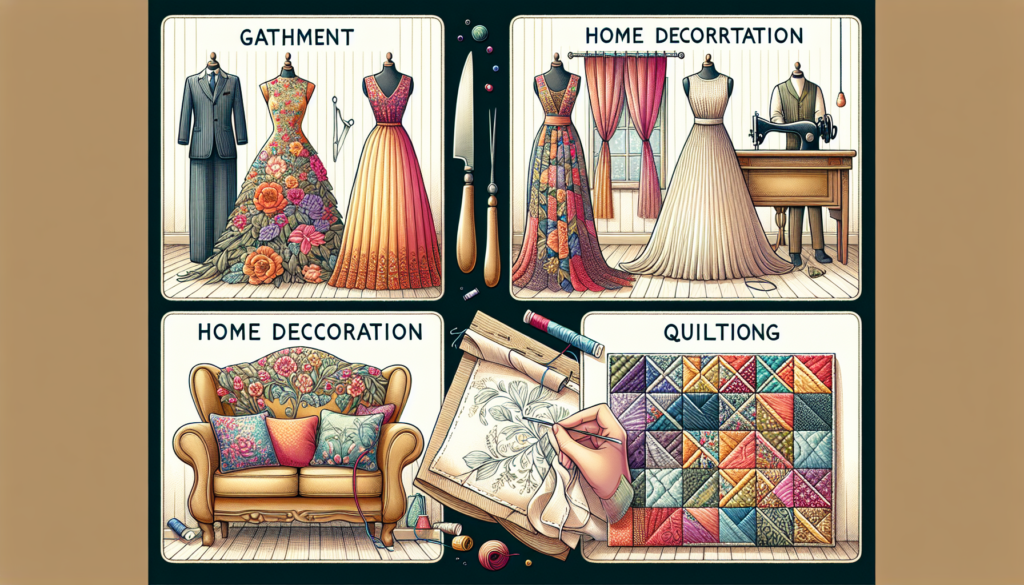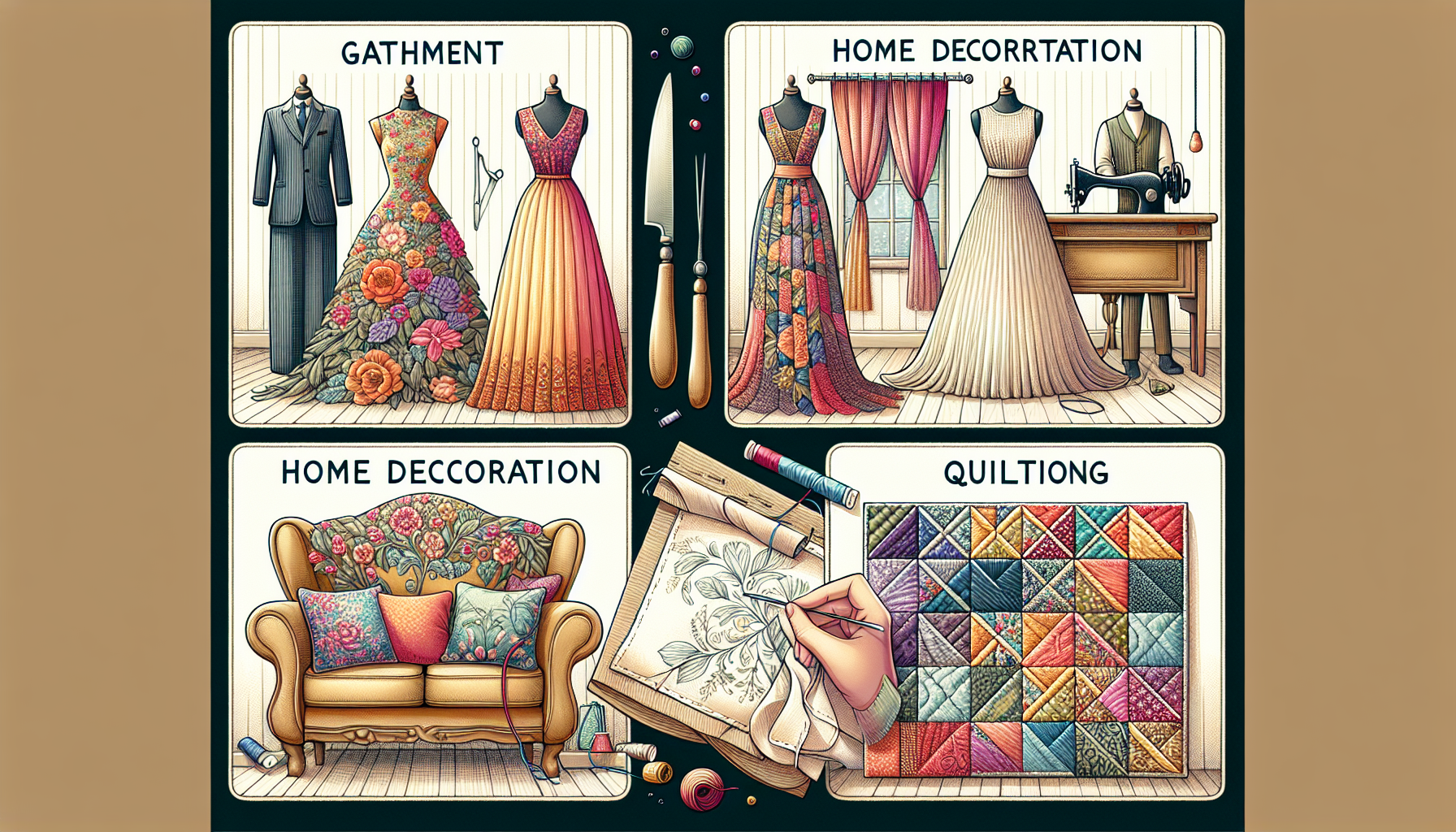If you’ve ever wondered about the different types of sewing that exist beyond basic stitch work, you’re in luck! In this article, we’ll explore and uncover the four main types of sewing that you may encounter in various projects. Whether you’re a beginner looking to expand your sewing skills or an experienced seamstress curious to learn more, this guide will provide you with a comprehensive overview of the different types of sewing techniques and their applications. So, grab your needle and thread, and let’s uncover the marvelous world of sewing!

Types of Sewing
If you’ve ever wondered about the different types of sewing techniques out there, you’ve come to the right place! Sewing is a beautiful art form that allows you to create and repair garments and fabric items, and there are various methods to achieve your desired results. In this article, we’ll explore the four main types of sewing: hand sewing, machine sewing, embroidery, and overlock sewing. Each has its own unique characteristics and purposes, so let’s dive in and learn more about them!
1. Hand Sewing
Hand sewing is the oldest and most traditional method of stitching fabric together. It requires using a needle and thread, and it allows for great precision and control. Hand sewing techniques are often favored for delicate fabrics and intricate details. Here are some common hand sewing techniques:
1.1 Running Stitch
The running stitch is one of the simplest and most basic hand sewing stitches. It involves making even, straight stitches along the fabric. This stitch is commonly used for basting, gathering fabric, or temporarily holding pieces together before sewing them permanently.
1.2 Backstitch
The backstitch is a strong, durable stitch that is commonly used for securing seams. It involves taking one step backward for every stitch forward, creating a continuous and sturdy line of stitching. This stitch is ideal for attaching zippers, sewing buttons, or reinforcing seams that receive a lot of stress.
1.3 Slipstitch
The slipstitch is a nearly invisible stitch used for hemming, attaching bindings, or closing openings in garments. It involves picking up just a few threads from each fabric edge and pulling the needle through, creating an almost imperceptible seam. This stitch allows for a clean and professional finish.
1.4 Blanket Stitch
The blanket stitch is primarily used for finishing raw fabric edges or attaching appliques. It creates a decorative edging that resembles the blanket stitch used to secure the layers of a quilt. This stitch is both functional and visually appealing.
1.5 Hem Stitch
The hem stitch is used to create a neat, invisible hem on garments or fabric items. It involves catching only a few threads from the garment and then the same amount of threads from the folded edge, creating a nearly invisible line of stitching. This stitch is perfect for achieving a professional finish on hems.
2. Machine Sewing
Machine sewing revolutionized the sewing industry when it was introduced in the 19th century. It allows for faster and more precise stitching, making it the go-to method for many sewists. Here are some common machine sewing techniques:
2.1 Straight Stitch
The straight stitch is the most basic machine stitch and is used for general sewing purposes. It creates a straight line of stitches that is perfect for construction, seaming, and topstitching. This stitch is versatile and is the foundation for many other machine stitches.
2.2 Zigzag Stitch
The zigzag stitch is used for neatening fabric edges, creating stretchable seams, or adding decorative elements to a project. This versatile stitch moves from side to side and creates a zigzag pattern when sewn. It is particularly useful for sewing knit fabrics or finishing raw edges.
2.3 Blind Hem Stitch
The blind hem stitch is used for creating nearly invisible hems on garments. It involves using a special sewing machine foot that folds and stitches the fabric in such a way that the stitches are hardly visible from the right side. This stitch is perfect for achieving a professional and polished look on hems.
2.4 Buttonhole Stitch
The buttonhole stitch is used for creating buttonholes or other similar fastening methods. Sewing machines have specific settings and attachments to make this stitch, allowing for precise and secure buttonholes. This stitch is essential for creating functional closures on garments or fabric items.
2.5 Decorative Stitches
Modern sewing machines often come with a range of decorative stitches that can be used to add unique and creative touches to your sewing projects. These stitches can be used for embellishments, embroidery-like designs, or to create beautiful borders. The possibilities are endless with decorative stitches!
3. Embroidery
Embroidery is a form of sewing that focuses on creating decorative designs on fabric using colorful threads and various stitching techniques. It allows for artistic expression and can transform plain fabric into stunning works of art. Here are some commonly used embroidery stitches:
3.1 Cross Stitch
Cross stitch is a popular embroidery technique that involves making X-shaped stitches on a fabric grid. It is often used to create intricate designs or patterns. Cross stitch can be done on both evenweave fabric and Aida cloth. This technique is commonly used in traditional embroidery and can result in beautiful and detailed designs.
3.2 Satin Stitch
The satin stitch is a dense and smooth stitch that is used to fill in shapes or create solid blocks of color in embroidery. It involves closely spaced straight stitches that cover the fabric surface, creating a satin or polished appearance. This stitch is perfect for adding texture and vibrant colors to your embroidery projects.
3.3 Chain Stitch
The chain stitch is a versatile stitch that is commonly used for creating outlines or decorative lines in embroidery. It involves creating loops with the thread and pulling the needle through each loop, creating a chain-like effect. This stitch can be used for creating intricate designs or adding texture to your embroidered pieces.
3.4 French Knots
The French knot is a small, raised stitch that is used to create textured accents or small dots in embroidery. It involves wrapping the thread around the needle multiple times before inserting it back into the fabric, creating a knot on the surface. French knots can be used to add dimension and detail to your embroidery projects.
3.5 Feather Stitch
The feather stitch is a decorative stitch that resembles the shape of a feather. It is commonly used for creating borders, decorative lines, or a row of hand embroidery stitches. The stitch involves creating a series of slanting stitches that alternate positions, creating a unique and visually appealing effect.
4. Overlock Sewing
Overlock sewing is a specialized technique that is primarily used for finishing the raw edges of fabric seams and preventing them from fraying. It is commonly seen on professionally made garments and is achieved using an overlock sewing machine. Here are some common overlock stitches:
4.1 Overlock Stitch
The overlock stitch is a type of stitch that simultaneously trims the fabric edge while sewing it with an overlock machine. This stitch encases the raw edge of the fabric and prevents fraying. It is commonly used for constructing and finishing seams on garments. The overlock stitch is strong, durable, and provides a clean and professional finish.
4.2 Flatlock Stitch
The flatlock stitch is a decorative stitch that joins two fabric edges together, creating a seam that lies flat. It is often used in activewear and sportswear to create strong, flexible seams that are smooth against the skin. The flatlock stitch creates a visually appealing seam that is functional and adds a unique design feature.
4.3 Rolled Hem Stitch
The rolled hem stitch is used to create a narrow and delicate hem on lightweight fabrics such as chiffon or silk. It involves rolling the fabric edge and sewing it with an overlock machine, creating a small, neat hem that is barely visible. This stitch is ideal for achieving a professional finish on delicate garments or fabric items.
4.4 Picot Edge Stitch
The picot edge stitch is a decorative stitch that creates a small, looped or scalloped edge on fabric. It is often used for adding a decorative touch to hems, sleeves, or edges of fabric items. The picot edge stitch is created using an overlock sewing machine with a special attachment or foot. This stitch adds texture and visual interest to your sewing projects.
4.5 Rolled Edge Stitch
The rolled edge stitch is similar to the rolled hem stitch, but it creates a wider, more pronounced hem. This stitch is commonly used for finishing lightweight or sheer fabrics, such as organza or tulle. It involves rolling the fabric edge and securing it with multiple rows of stitching. The rolled edge stitch adds volume and a feminine touch to your garments or fabric items.
Now that you have a better understanding of the different types of sewing techniques, you can explore and experiment with these methods to enhance your sewing skills. Whether you prefer the precision of machine sewing, the artistry of embroidery, or the versatility of hand sewing, there is a technique out there for you. So, grab your needles, threads, and sewing machines, and let your creativity shine through your sewing projects! Happy stitching!

